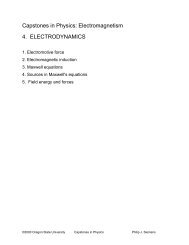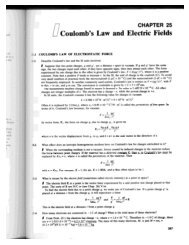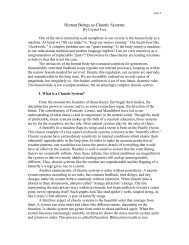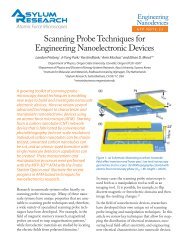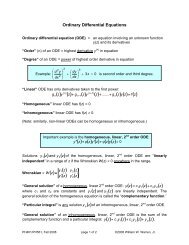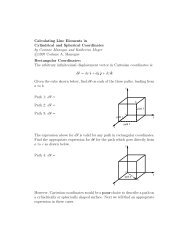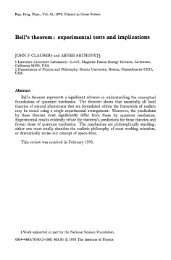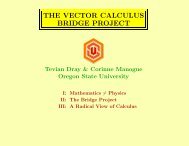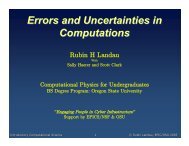Putting differentials back into calculus - Department of Mathematics ...
Putting differentials back into calculus - Department of Mathematics ...
Putting differentials back into calculus - Department of Mathematics ...
You also want an ePaper? Increase the reach of your titles
YUMPU automatically turns print PDFs into web optimized ePapers that Google loves.
discussing linear approximation, the door would be left open for those who so chooseto use <strong>differentials</strong> to do <strong>calculus</strong>, with all <strong>of</strong> the advantages we have described.Science is about physical quantities, not functions. Mathematicians justifiably pridethemselves on the development <strong>of</strong> a rigorous <strong>calculus</strong> <strong>of</strong> functions, but it is rather the<strong>calculus</strong> <strong>of</strong> physical quantities which is relevant to scientists. Whether one regards<strong>differentials</strong> as the conceptual core <strong>of</strong> <strong>calculus</strong>, as we do, or merely a heuristic tool,they reflect the way many <strong>of</strong> our pr<strong>of</strong>essional colleagues think about <strong>calculus</strong>. Thisinvaluable tool should be emphasized, not relegated to a recently-invented role in linearapproximation, for which it is neither suited nor needed.Surely we should encourage the teaching <strong>of</strong> a concept which captures the intuitiveessence <strong>of</strong> <strong>calculus</strong>, which is easy for students to master, and which always producescorrect answers.Acknowledgment. This work was supported in part by NSF grant DUE–0618877.Summary. We argue that the use <strong>of</strong> <strong>differentials</strong> in introductory <strong>calculus</strong> courses providesa unifying theme which leads to a coherent view <strong>of</strong> <strong>calculus</strong>. Along the way, we will meetseveral interpretations <strong>of</strong> <strong>differentials</strong>, some better than others.References1. C. B. Allendoerfer, Differentials (editorial), Amer. Math. Monthly 59 (1952) 403–406; reprinted in [2].2. T. M. Apostol, et al., eds., Selected Papers on Calculus, Mathematical Association <strong>of</strong> America, WashingtonDC, 1969.3. J. Bair and V. Henry, From mixed angles to infinitesimals, College Math. J. 39 (2008) 230–233.4. G. Berkeley, The analyst, in From Kant to Hilbert: A Source Book in the Foundations <strong>of</strong> <strong>Mathematics</strong>,Vol.1,William Ewald, ed., Oxford University Press, Oxford, 1996; reprint <strong>of</strong> pamphlet distributed in 1734; availableat http://www.maths.tcd.ie/pub/HistMath/People/Berkeley/Analyst/Analyst.pdf.5. A. Church, Differentials, Amer. Math. Monthly 49 (1942) 389–392; reprinted in [2]. doi:10.2307/23031366. R. Dawson, Differentiate early, differentiate <strong>of</strong>ten!, College Math. J. 36 (2005) 404–407.7. T. Dray and C. A. Manogue, The vector <strong>calculus</strong> gap, PRIMUS 9 (1999) 21–28; available at http://www.math.oregonstate.edu/bridge/papers/<strong>calculus</strong>.pdf. doi:10.1080/105119799089659138. , Conventions for spherical coordinates, College Math. J. 34 (2003) 168–169; available at http://www.math.oregonstate.edu/bridge/papers/spherical.pdf.9. , Using <strong>differentials</strong> to bridge the vector <strong>calculus</strong> gap, College Math. J. 34 (2003) 283–290; availableat http://www.math.oregonstate.edu/bridge/papers/use.pdf. doi:10.2307/359576510. H. Flanders, Differential Forms with Applications to the Physical Sciences, Academic Press, New York, 1963;reprinted by Dover, Mineola NY, 1989.11. M. K. Fort, Jr., Differentials, Amer. Math. Monthly 59 (1952) 392–395; reprinted in [2]. doi:10.2307/230681412. D. J. Griffiths, Introduction to Electrodynamics, 3rd edition, Prentice-Hall, New York, 1999.13. M. Kac and J. F. Randolph, Differentials, Amer. Math. Monthly 49 (1942) 110–112; reprinted in [2]. doi:10.2307/230266614. H. J. Keisler, Elementary Calculus: An Infinitesimal Approach, 2nd ed., PWS, Boston, 1982; available athttp://www.math.wisc.edu/~keisler/calc.html.15. G. Leibniz, New method for maximums and minimums, in A Source Book in <strong>Mathematics</strong>, 1200–1800, DirkJan Struik, ed., Harvard University Press, Cambridge MA, 1969; translation <strong>of</strong> Nova methodus pro maximiset minimis, pamphlet distributed in 1684.16. W. G. McCallum, review <strong>of</strong> Calculus Mysteries and Thrillers by R. G. Woods and How To Ace Calculus: TheStreetwise Guide by C. Adams, J. Haas, and A. Thompson, Amer. Math. Monthly 108 (2001) 90–93. doi:10.2307/269570017. W. McCallum, D. Hughes-Hallett, A. Gleason, et al., Calculus, 4th ed., Wiley, Hoboken NJ, 2005.18. C. G. Phipps, The relation <strong>of</strong> differential and delta increments, Amer. Math. Monthly 59 (1952) 395–398;reprinted in [2]. doi:10.2307/230681519. W. R. Ransom, Bringing in <strong>differentials</strong> earlier, Amer. Math. Monthly 58 (1951) 336–337; reprinted in [2].doi:10.2307/2307725VOL. 41, NO. 2, MARCH 2010 THE COLLEGE MATHEMATICS JOURNAL 99



